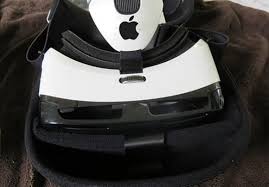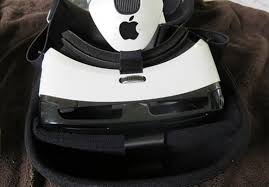
As Apple seeks new sources of growth beyond the iPhone, the IT giant has reportedly built prototypes of headsets that could one day rival Facebook’s Oculus Rift or Microsoft’s Hololens and has assembled a large team of experts in virtual and augmented reality.
Sources in the industry and media reports suggest that Apple has carefully structured the research unit and very secretly. The unit includes employees poached from companies that are working on next-generation headset technologies that includes Microsoft and camera start-up Lytro as well as hundreds of staff from a series of carefully targeted acquisitions.
Flyby Media, an augmented reality start-up that lets mobile devices “see” the world around them is the latest acquisition by Apple in the area of virtual reality. In the project of the development of software for 3D positioning technology Project Tango of Google was closely assisted by Flyby’s team.
Prototypes of possible headset configurations have been build by Apple for several months now.
As companies from Facebook and Google to Microsoft and Samsung eye the next big technology platform, Apple joins a growing focus in Silicon Valley on VR and AR.
There were recent reports published in the Financial Times that Apple had hired Doug Bowman, a leading VR researcher which has enhanced the rumors about the VR project of the company.
Technology had a broad appeal, declared Apple’s chief executive, Tim Cook, earlier this week.
“It is really cool and has some interesting applications,” Cook said on Tuesday, as Apple reported iPhone sales growth had slowed to a halt.
Even in the past, there have been experiments with virtual reality that Apple has been engaged in. A small team created prototypes and filed patents on putative devices under co-founder Steve Jobs in the mid-2000s before the company abandoned the idea as the technology was deemed immature.
After a series of Apple job advertisements appeared seeking software engineers to “create high performance apps that integrate with virtual reality systems for prototyping and user testing”, some VR patents were revealed early last year.
The emergence of Oculus, which was acquired by Facebook for $2bn in 2014 possibly had rekindled Apple’s interest in the sector. Oculus’s founder Palmer Luckey partially financed his research into VR by repairing broken iPhones as the company’s first headset prototype used smartphone panels for its display.
Apple stepped up its recruiting and dealmaking in VR and AR with the purchases of Metaio and Faceshift after buying Israeli motion-sensing company PrimeSense in 2013.
Sources within the industry claimed that in order to enable it to complete its project Apple is still seeking further acquisitions in optical technologies.
The Metaio deal had particularly accelerated the hiring spree by Apple over the past year.
Apple has recruited several former employees from Lytro, a Silicon Valley start-up that launched the first consumer camera to use “light field” optics to capture a scene apart from recruiting Bowman, a computer science professor from Virginia Tech as well as Microsoft’s Hololens team.
Apple is reportedly vying to push for a more ambitious augmented-reality device akin to Microsoft’s forthcoming Hololens and Magic Leap. However it is unclear when Apple plans to release a headset, or whether its device will compete with the likes of Googles Cardboard and Samsung’s Gear VR in mobile virtual reality.
The secret car project of Apple can also be helped by the skills and technologies it has assembled in imaging and positioning. Apple might again decide not to release a headset even though its latest VR efforts are said to be much more advanced than those of 10 years ago.
There has so far been no official comment from Apple about its VR activities.
(Source:www.ft.com)
Sources in the industry and media reports suggest that Apple has carefully structured the research unit and very secretly. The unit includes employees poached from companies that are working on next-generation headset technologies that includes Microsoft and camera start-up Lytro as well as hundreds of staff from a series of carefully targeted acquisitions.
Flyby Media, an augmented reality start-up that lets mobile devices “see” the world around them is the latest acquisition by Apple in the area of virtual reality. In the project of the development of software for 3D positioning technology Project Tango of Google was closely assisted by Flyby’s team.
Prototypes of possible headset configurations have been build by Apple for several months now.
As companies from Facebook and Google to Microsoft and Samsung eye the next big technology platform, Apple joins a growing focus in Silicon Valley on VR and AR.
There were recent reports published in the Financial Times that Apple had hired Doug Bowman, a leading VR researcher which has enhanced the rumors about the VR project of the company.
Technology had a broad appeal, declared Apple’s chief executive, Tim Cook, earlier this week.
“It is really cool and has some interesting applications,” Cook said on Tuesday, as Apple reported iPhone sales growth had slowed to a halt.
Even in the past, there have been experiments with virtual reality that Apple has been engaged in. A small team created prototypes and filed patents on putative devices under co-founder Steve Jobs in the mid-2000s before the company abandoned the idea as the technology was deemed immature.
After a series of Apple job advertisements appeared seeking software engineers to “create high performance apps that integrate with virtual reality systems for prototyping and user testing”, some VR patents were revealed early last year.
The emergence of Oculus, which was acquired by Facebook for $2bn in 2014 possibly had rekindled Apple’s interest in the sector. Oculus’s founder Palmer Luckey partially financed his research into VR by repairing broken iPhones as the company’s first headset prototype used smartphone panels for its display.
Apple stepped up its recruiting and dealmaking in VR and AR with the purchases of Metaio and Faceshift after buying Israeli motion-sensing company PrimeSense in 2013.
Sources within the industry claimed that in order to enable it to complete its project Apple is still seeking further acquisitions in optical technologies.
The Metaio deal had particularly accelerated the hiring spree by Apple over the past year.
Apple has recruited several former employees from Lytro, a Silicon Valley start-up that launched the first consumer camera to use “light field” optics to capture a scene apart from recruiting Bowman, a computer science professor from Virginia Tech as well as Microsoft’s Hololens team.
Apple is reportedly vying to push for a more ambitious augmented-reality device akin to Microsoft’s forthcoming Hololens and Magic Leap. However it is unclear when Apple plans to release a headset, or whether its device will compete with the likes of Googles Cardboard and Samsung’s Gear VR in mobile virtual reality.
The secret car project of Apple can also be helped by the skills and technologies it has assembled in imaging and positioning. Apple might again decide not to release a headset even though its latest VR efforts are said to be much more advanced than those of 10 years ago.
There has so far been no official comment from Apple about its VR activities.
(Source:www.ft.com)





